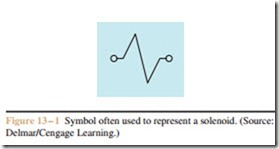Valves are employed throughout industry to control the flow of both liquids and gasses. Many valves are manually operated by turning a handle, but in industrial applications, electrically operated valves are generally used. Electrically operated valves can be placed near the equipment they operate, which helps to minimize the amount of piping required. Also, electrically operated valves can be controlled from remote locations by running a pair of wires from the control station to the valve.
Solenoid Valves
Solenoid valves contain two distinct parts, the electrical part and the valve part. The electrical part consists of a coil of wire that supplies an electromagnetic field that operates the plunger or core. When the solenoid coil is energized, the plunger is drawn into the coil, opening or closing the valve. Solenoid valves can be opened or closed when de-energized. If the valve is normally closed, it will open when the solenoid is en- ergized. The plunger will return to its normal position when the solenoid is de-energized. Most valves contain a spring that re-seats the valve when de-energized. Some valves are normally open and will close when energized. They will return to their normal open state when the solenoid is de-energized.
Although solenoid valves are very similar to the so- lenoid used to operate relays and contacts, the symbol used to represent a solenoid valve is often drawn differently. Relay and contactor coils are generally represented by a circle. Solenoid valves are often rep- resented by the symbol shown in Figure 13–1.
Two-Way Solenoid Valves
Two-way valves are used to control the flow of liquids or gasses. They are digital devices in that they are completely on or completely off. They do not have the ability to control the rate of flow. Two-way valves have an inlet and an outlet and are connected directly into the pipe line. The inlet and outlet should not be re- versed, because the valve is designed is such a manner that the pressure of the inlet liquid or gas is used to help maintain a seal (Figure 13–2). The valve contains a wedge-shaped disc that seats against a wedge-shaped seat. The inlet pressure forces the disc against the seat to help provide a more secure seal. If the valve is reversed, the inlet pressure tries to force the disc up against the spring. If the pressure is great enough, it can cause the valve to leak.
Four-Way Solenoid Valves
Four-way valves are generally used to control the air supplied to double acting cylinders (Figure 13–3). When the valve is de-energized, one side of the cylinder is open to atmospheric pressure, and the other side is supplied by line pressure. When the solenoid coil is energized, the valve permits the high pressure side to exhaust to the atmosphere and the side that was previously open to the atmosphere to be supplied by line pressure. The piston inside the cylinder will move back and forth in accord with the solenoid being energized or de-energized. The speed of the piston’s movement is determined by the amount of air pressure, the surface area of the piston, and the amount of force the load places against the piston.
